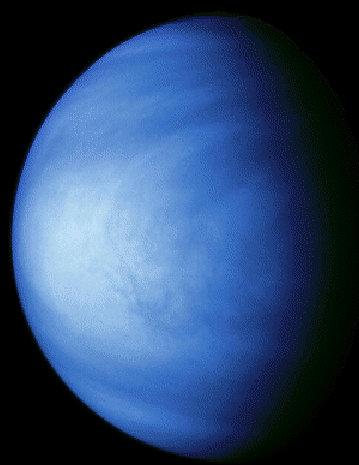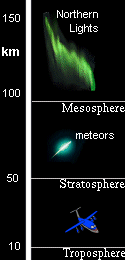
However, her beauty is only skin deep. Below the dense shroud of clouds lies the most extreme hell known in our solar system. The surface temperature of Venus, 750 K (477 C, 891 F), is great enough to melt lead. In more respects than not, Venus is similar in characteristics to Earth (mass, radius, geology and chemistry). What went wrong?

The Venusian Atmosphere. The key is the atmosphere: a greenhouse effect gone bizzerk! Venus shows us how powerful this effect can be, heating the planet 500 K (almost 1000 F) above what it's equilibrium temperature would be without an atmosphere.
|
|

| <--- Earth's atmosphere. Clouds extend to the top of the troposphere, about 10-11 miles up. Despite the diagram, typical planes fly in the troposphere, up to 7 miles above the ground. Above that is the stratosphere, at 30 miles, famous for its ozone. At 60-80 km (40-50 miles) the atmosphere becomes dense enough that entering meteors heat up and glow. Above the Stratosphere, at > 80 miles, is the mesosphere, where the Northern Lights originate. Above the mesosphere, at > 200 miles, is where the Space Shuttle flies. |
Clouds form at the top of the Venusian troposphere, just like on Earth and at the same Temp (around freezing temperatures) and pressure, only at 60 km above the surface. The closer to the surface, the hotter it gets. The Venusian clouds are made up of sulfuric acid droplets and they zip around the planet at 300 km/h! The total mass of cloud material is not great, it would form a liquid layer of only 0.1 mm thick on the surface. However, these clouds are effective at blocking much of the Sun's light from getting to the surface.. So why does it get so hot?